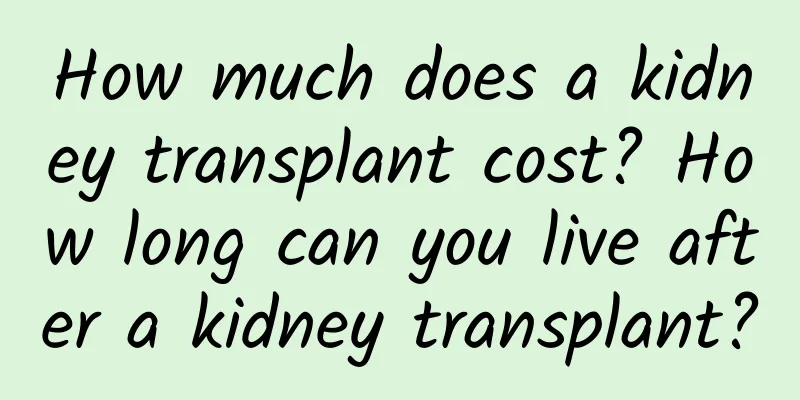How much does a kidney transplant cost? How long can you live after a kidney transplant?

|
Although kidney transplantation is the best way to treat end-stage renal disease, its high cost and scarce kidney sources still make it an unattainable treatment for the vast majority of end-stage renal disease patients in China. Its treatment is related to the lives and family happiness of tens of millions of patients. So why is the cost of kidney transplantation so expensive? How long can a kidney disease patient live after a kidney transplant? What are the treatments for end-stage renal disease? End-stage renal disease is the terminal stage of the development of chronic kidney disease, which is mainly manifested by a significant decline in renal metabolic capacity. The body's metabolic waste cannot be discharged autonomously, causing electrolyte imbalance, which in turn causes a series of poisoning symptoms, commonly known as uremia. Renal replacement therapy is the main treatment for patients with end-stage renal disease in clinical practice, including hemodialysis, peritoneal dialysis, and kidney transplantation. Among them, hemodialysis has lower treatment costs than kidney transplantation and is currently the most widely used in clinical practice. However, hemodialysis fluid often has many complications, such as renal anemia, dialysis hypertension, dialysis hypotension, and uremic skin pruritus, which will seriously affect the patient's quality of life and physical and mental health, and cannot play a fundamental therapeutic role. Studies have shown that kidney transplant patients currently have the best quality of life, better than hemodialysis and peritoneal dialysis patients. However, the cost of kidney transplant treatment is too expensive and many ordinary families cannot afford it, so the treatment rate is still very low. How much does a kidney transplant cost? In the United States, the average cost of a kidney transplant is more than 2 million. In my country, the cost of a kidney transplant is about 400,000 (the specific cost varies from hospital to hospital). This includes preoperative matching, evaluation, and preparation; intraoperative costs and anesthesia; and postoperative recovery medication and hospitalization costs. The main costs are the cost of the kidney donor and the long-term use of immunosuppressants after surgery. The cost of kidney source: The first step of kidney transplantation is to find a kidney source. Currently, the sources of kidneys mainly include living relatives and non-living relatives. Living relatives generally do not need to pay for kidney transplantation, while non-living relatives need to pay a certain fee. In addition, the relevant costs such as early matching examinations are relatively fixed. Cost of immunosuppressants: **Kidney transplant patients need to use immunosuppressants for a long time after the transplant, mainly to reduce kidney transplant rejection. Immunosuppressants need to be used for a long time, and the prices of different types of immunosuppressants vary greatly. The annual cost is about 60,000 yuan, which is also very expensive. Cost of prevention and treatment of postoperative complications: Due to the long-term use of immunosuppressants by kidney transplant patients, their immune function will decline and they are prone to lung infection. At this time, they need to receive anti-infective drug treatment. These drugs are also relatively expensive. At the same time, severe lung infection will increase the cost of care and treatment and significantly prolong the hospitalization time, which leads to a significant increase in perioperative costs. In addition, immune induction therapy, acute rejection reactions and delayed recovery of renal function will increase the economic burden on patients. How long can you live after a kidney transplant? The success rate of kidney transplantation is relatively high, at over 95%. The survival rate of patients after surgery needs to be considered comprehensively based on the patient's renal function recovery status, lifestyle, and other aspects. If the patient's renal function recovers well after surgery, and his physical condition is also relatively good, and he can follow the doctor's advice and fully monitor his renal function, then the patient's survival rate is still very high. Currently, there are cases in the world where the patient has survived up to 48 years after kidney transplantation. Summarize In short, no matter how high or low the cost of kidney transplantation is, and whether we can afford it or not, in our daily lives, the most important thing is to protect our kidney health from the source, develop good living habits, drink more water, hold urine less, eat a low-sodium diet, and have regular physical examinations, which are the best protection for our kidneys. |
<<: You must know these 4 invisible "killers" that harm your kidneys!
>>: Thyroid cancer is besieging more and more young people
Recommend
What to do if bleeding occurs 25 days after transplantation
Embryo transplantation is an important method to ...
What are the symptoms of post-abortion sequelae?
At present, with the continuous development of me...
Silver Age Health丨Highly Prevalent Diseases that Elderly People Need to Prevent in Winter
As winter quietly approaches, the air becomes col...
What to do if you have vaginal bleeding during your period
Vaginal bleeding in women is a very normal phenom...
Why is the wound turning white? Improper wound treatment
In life, there will inevitably be bumps and bruis...
Pain and numbness? Lumbar disc herniation can be relieved with a few simple movements →
Lumbar disc herniation is one of the common "...
#千万IP创科普# Master the little "intestinal" knowledge and refuse to be a "feces" fighter
Why can some people defecate in one go, while oth...
When the cold wind blows, my waist and legs ache. What should I do? See here →
As the weather gets colder, do you often feel sti...
What to do if nipples itch after weaning
Many people, after becoming mothers, will face a ...
What is the reason for less black menstrual discharge?
Every month when menstruating, women should learn...
Different cases of breast pain in women
Breast pain in women is a relatively common breas...
Treat knee osteoarthritis with Chinese medicine and acupuncture to restore knee health
Knee osteoarthritis is a common chronic joint dis...
What causes breast pain after childbirth?
Postpartum breast pain is a problem that troubles...
What causes a lump in the vagina?
We can usually find foreign objects on the skin o...









